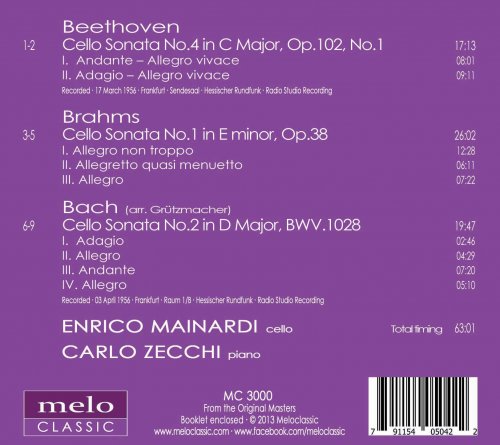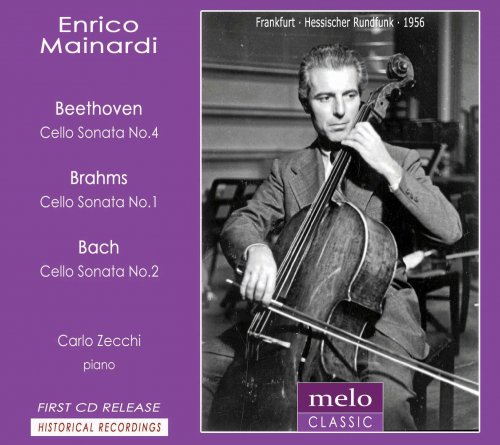Enrico Mainardi was born on May 19, 1897 in Milan. His talents were nurtured from an early age. He was given a small cello at the age of three as Christmas gift in 1900, and he had his initial lessons under his father, an amateur cellist. He then studied with Giuseppe Magrini at the Milan Conservatory between 1902 and 1910. Music society noticed his talent, among those Respighi. After graduating Giuseppe Verdi Milan Conservatory in 1910, 13 year old Mainardi visited Hugo Becker (1863-1941) at his summer house at Lake Como and became his pupil at the Hochschule für Musik in Berlin. He also studied composition with Giacomo Orefice in Milan.In 1910, he gave his first orchestral performance playing the Haydn Cello Concerto with the Berlin Philharmonic under Ernst Kunwald. At the age of 16 he played Reger’s Fourth Cello Sonata op.116 with the composer himself as accompanist at the Heidelberg Bach-Reger Festival. His teacher Becker refused to learn and perform this sonata and recommended Mainardi for the performance.
He made his Vienna début on 07 February 1914 playing the Dvořák Cello Concerto with the Tonkünstler Orchestra under Rudolf Nilius. In the same year he gave chamber music recitals with Ernst von Dohnányi in Germany and Moriz Rosenthal in Vienna. In 1915, Italy declared war on Austria-Hungary, entering World War I and it made impossible for Mainardi to continue touring outside of Italy. His recital on 03 December 1916 in Milan at the Sala Piccola del Conservatorio G. Verdi with Aldo Solito De Solis at the piano, received great public acclaim. In 1921, he gave several performances with Wilhelm Backhaus including R. Strauss’s Cello Sonata. Mainardi was first cello of the Dresden Philharmonic Orchestra together with Stefan Auber under Eduard Mörike between 1924 and 1929. He formed the string quartet of the Dresden Philharmonic Orchestra with Simon Goldberg (1st violin), Joseph Lasek (2nd violin) and Herbert Ronnefeld (viola). Erich Kleiber, who conducted frequently in Dresden, convinced Mainardi to join the Berlin State Opera as solo cellist in 1929. In 1931, he once accompanied Piatigorsky at the piano in the Debussy Cello Sonata in Berlin.
On another occasion they had fun playing Popper’s Elfentanz – with Piatigorsky standing behind Mainardi fingering the piece while Mainardi bowed. In 1932, he decided to resume his solo career and left the Berlin State Opera and performed a tour in Soviet Union. In 1933, Richard Strauss invited Mainardi to record Don Quixote in Berlin, with the composer conducting and in the same year, he was appointed professor of cello at Santa Cecilia and in 1941, succeeded his teacher Becker at the Hochschule für Musik in Berlin on the latter’s death. He performed the world premiere of Pizzetti’s Cello Concerto in Venice, written for Mainardi, and conducted by the composer in 1934 and the world premiere of Malipiero’s Cello Concerto in 1938.
He recorded Pizzetti’s Cello Concerto with the Frankfurter Funkorchester under Hans Rosbaud for the German Reichssender Frankfurt and Boccherini’s Cello Concerto No. 9 in B flat Major with the Breslauer Funkorchester under Ernst Prade for the German Reichssender Breslau in 1934. Subsequently, Mainardi’s professional career in the thirties flourished in direct proportion to the enforced emigration of leading cellists in Germany. He was very much in demand in Italy and Germany and very busy during the Nazi period to perform in countries occupied by the Nazis. In 1939, he formed a duo with pianist Carlo Zecchi, who became a favourite partner. In 1941, he founded a famous piano trio together with Edwin Fischer and Georg Kulenkampff, who died in 1948 and was later replaced by Wolfgang Schneiderhan. Mainardi and Kulenkampff often played Brahms’ Double Concerto together.
In an interview Mainardi admitted: “I regret not having performed with Toscanini, Walter and Klemperer.” It took him a while to re-establish his career internationally after World War II. He became especially known for his chamber music performances. He extended his fame in Germany through much of the rest of Europe, though he did not become popular in France or England. However, even in those countries he was recognized as one of the great teachers of the instrument. In 1967, he also founded a trio with the pianist Guido Agosti and the flutist Severino Gazzelloni. Mainardi was married to Ada Colleoni (1897-1979), a pianist from the Milan Conservatory. They had frequent concert tours all over Europe, but by the mid-1930s their marriage seemed to have been troubled, and they both had numerous extramarital affairs. They never officially divorced. Sela Sommer had been Mainardi’s companion in his last years from 1964 until his death.
Mainardi wrote four concertos for cello and orchestra, and many other works, including cadenzas for some of the major cello concertos. He also held summer classes in Salzburg and Lucerne. He was a long-time resident of Germany, spending his last years teaching and composing for the cello at his lakeside home of Breitbrunn on Lake Ammer.
Mainardi died in a Munich clinic after a brief illness on April 10, 1976
Tracks:
1-2. BEETHOVEN: Cello Sonata No.4 in C Major, Op.102, No.1 [17:13]
Recorded · 17 March 1956 · Frankfurt · Sendesaal · Hessischer Rundfunk · Radio Studio Recording
3-5. BRAHMS: Cello Sonata No.1 in E minor, Op.38 [26:02]
6-9. BACH: Cello Sonata No.2 in D Major, BWV.1028 (arr. Grützmacher) [19:47]
Recorded · 03 April 1956 · Frankfurt · Raum 1/B · Hessischer Rundfunk · Radio Studio Recording
Personnel:
Enrico Mainardi · cello
Carlo Zecchi · piano




